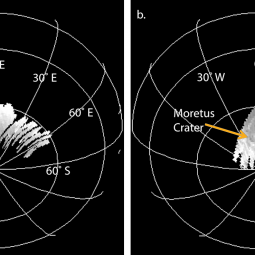By Anicia Arredondo
Paper:
Regional Map of Molecular Water at High Southern Latitudes on the Moon Using 6 μm Data From the Stratospheric Observatory for Infrared Astronomy
C.I. Honniball, et al., Geophysical Research Letters 2022.
Following the first ever detection of the water molecule (H 2 O) on the sunlit surface of the Moon, researchers using SOFIA have produced a regional map of the South Pole near Moretus crater. This map enables tests of various hypotheses for water formation and suggests that lunar surface water is created from pre-existing surface hydroxyl (OH) subsequently trapped in glass created during impacts.
The water molecule is a key compound for understanding the interaction of airless planetary surfaces with the space environment. In the contemporary era, water molecules have two principal styles of emplacement in the space weathering process: 1) they can be introduced directly into the lunar environment via micrometeorite impacts or 2) synthesized from solar wind hydrogen. While characterizing the behavior and origin of water is important to understanding the planetary process that is space weathering, it is of topical importance owing to the value of water for the progress of space exploration.
Previous investigations into understanding the distribution of water on the Moon made use of an absorption feature in reflectance spectra near 3 µm that is caused by stretching between hydrogen and oxygen atoms. This feature can be caused by both H 2 O and OH, making it impossible to distinguish between the two compounds. The 6 µm feature, on the other hand, is caused by bending of the H-O-H molecular bond and therefore unambiguously points to H 2 O.
Due to its ability to fly over 99% of the Earth’s atmosphere, SOFIA is one of the only observatories that can observe in the region near 6 µm. This, combined with the sensitivity of the FORCAST spectrometer, allows for the measurement of the strength of the 6 µm feature, which may vary across the surface due to changes in the water abundance.
The previous detection of molecular water by SOFIA was made by observing the same spot near the lunar Clavius crater multiple times. For this new observation, the telescope was moved by the width of the slit after every exposure, thus creating a spectral map of the surface. This demonstrated that FORCAST could be used as an imaging spectrometer. This was the first time a map like this was attempted by SOFIA, and it showed the possibility that SOFIA observations can be used to measure how the surface water changes.
The estimated abundance of water based on the strength of the emission feature is a couple hundred parts per million, in agreement with the amount found in the nearby Clavius crater. This amount of surface water probably cannot be freely exchanging with the Moon’s tenuous exosphere because it would require much more water in the exosphere than has been measured by spacecraft.
The measurements also point to an inverse correlation with surface temperature, where colder regions have greater abundance. The distribution of water is consistent with derivation of water from pre-existing hydroxyl subsequently trapped in impact glass, provided hydroxyl increases with latitude as some models and measurements suggest.
Further observations with SOFIA have created water maps of various regions on the Moon, including interesting geologic features such as craters and pyroclastic flows. Observations of multiple latitudes at multiple lunar times of day will constrain hypotheses about the origin, distribution, and evolution of lunar water. These observations will be critical for future NASA missions such as the VIPER lunar rover and the Artemis program that will return humans to the Moon by 2024.
